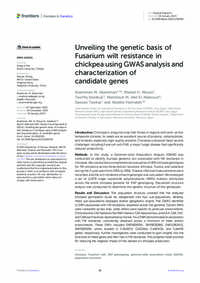Unveiling the genetic basis of Fusarium wilt resistance in chickpea using GWAS analysis and characterization of candidate genes

Authors:
Introduction: Chickpea is a legume crop that thrives in regions with semi-arid or temperate climates. Its seeds are an excellent source of proteins, carbohydrates, and minerals, especially high-quality proteins. Chickpea cultivation faces several challenges including Fusarium wilt (FW), a major fungal disease that significantly reduces productivity.
Methods: In this study, a Genome-wide Association Analysis (GWAS) was conducted to identify multiple genomic loci associated with FW resistance in chickpea. We conducted a comprehensive evaluation of 180 chickpea genotypes for FW resistance across three distinct locations (Ethiopia, Tunisia, and Lebanon) during the 2-year span from 2015 to 2016. Disease infection measurements were recorded, and the wilt incidence of each genotype was calculated. We employed a set of 11,979 single nucleotide polymorphisms (SNPs) markers distributed across the entire chickpea genome for SNP genotyping. Population structure analysis was conducted to determine the genetic structure of the genotypes.
Results and Discussion: The population structure unveiled that the analyzed chickpea germplasm could be categorized into four sub-populations. Notably, these sub-populations displayed diverse geographic origins. The GWAS identified 11 SNPs associated with FW resistance, dispersed across the genome. Certain SNPs were consistent across trials, while others were specific to particular environments. Chromosome CA2 harbored five SNP markers, CA5 featured two, and CA4, CA6, CA7, and CA8 each had one representative marker. Four SNPs demonstrated an association with FW resistance, consistently observed across a minimum of three distinct environments. These SNPs included SNP5826041, SNP5825086, SNP11063413, SNP5825195, which located in CaFeSOD, CaS13like, CaNTAQ1, and CaAARS genes, respectively. Further investigations were conducted to gain insights into the functions of these genes and their role in FW resistance. This progress holds promise for reducing the negative impact of the disease on chickpea production.
